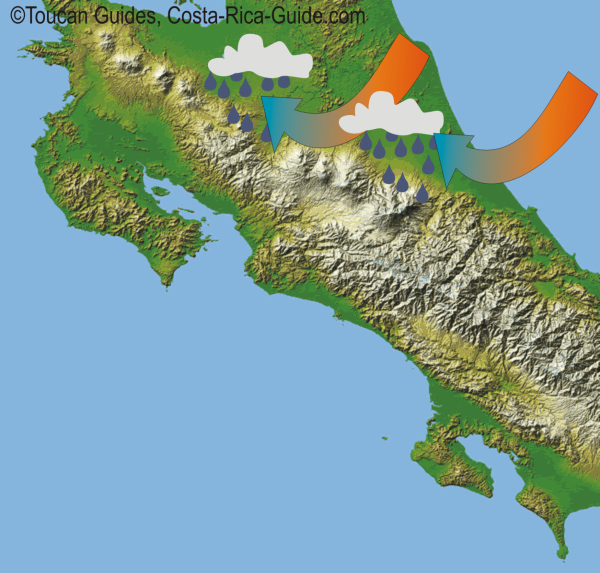One of the most unique environments in the world survives on Costa Rica’s mountaintops. Cloud forests like Monteverde’s are formed by a combination of wind and geography.

When trade winds flow from the northeast across the warm Caribbean Sea they drive moist air into the Cordillera Tilarán. The slope of the mountains pushes the air upwards allowing it to expand and cool. Since cool air holds less moisture the excess humidity forms tiny droplets, mist and clouds.
When tiny droplets are deposited on surfaces before they collect together and fall as rain it’s called horizontal precipitation and in cloud forests it can be the main source of moisture.

Peaks enveloped by trade wind-derived clouds can capture huge amounts of water when they are covered with tropical montane cloud forests. Their sponge-like epiphytes (mosses, ferns and bromeliads) massively increase the surface area for horizontal precipitation. The whole ecozone functions as a water regulator-soaking it up in the rainy season (preventing erosion), and releasing vapor to the atmosphere and runoff downstream in the dry season.

Cloud forests are distinctive biologically as well. They don’t quite match the biodiversity found in the world champion ecozone-tropical lowland rainforests-but they exceed them in uniqueness. The concentration of endemics (species found in only one location) is higher than other locations except for islands like the classic example at Galapagos which are isolated by the ocean.
The most famous cloud forest in Costa Rica and perhaps in the world is Monteverde, but there are dozens of other excellent examples at Braulio Carrillo, Los Quetzales, Tapanti, Turrialba, Miravalles, Cerro Chirripo, Tenorio and other national parks.
Now that’s what I call a cloud forest lodge. You can actually see the clouds blowing through the front door and across the fireplace lounge at Villa Blanca.
Deforestation eliminated most of the world’s tropical montane cloud forests years ago and continues today. Unfortunately even areas like Monteverde Cloud Forest Reserve which are protected from logging are threatened as rising world temperatures move the elevation where the clouds first form higher and higher.
Scientists have found that plants and animals from lower climactic associations have been encroaching on the reserve and other Costa Rican cloud forest areas for decades.
The lowland rainforests are creeping up the hills and the cloudforests are being pushed off the mountaintops. Visit while you still can.
